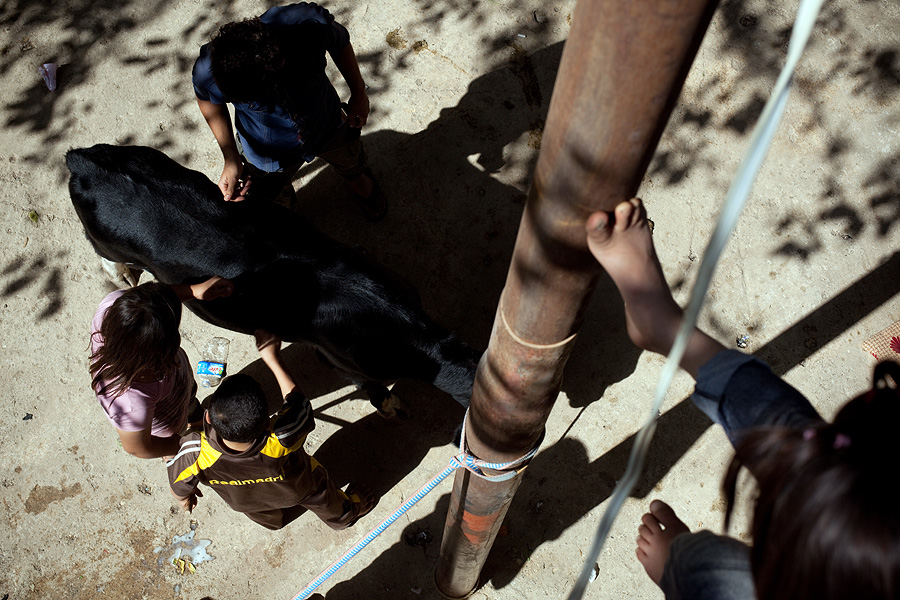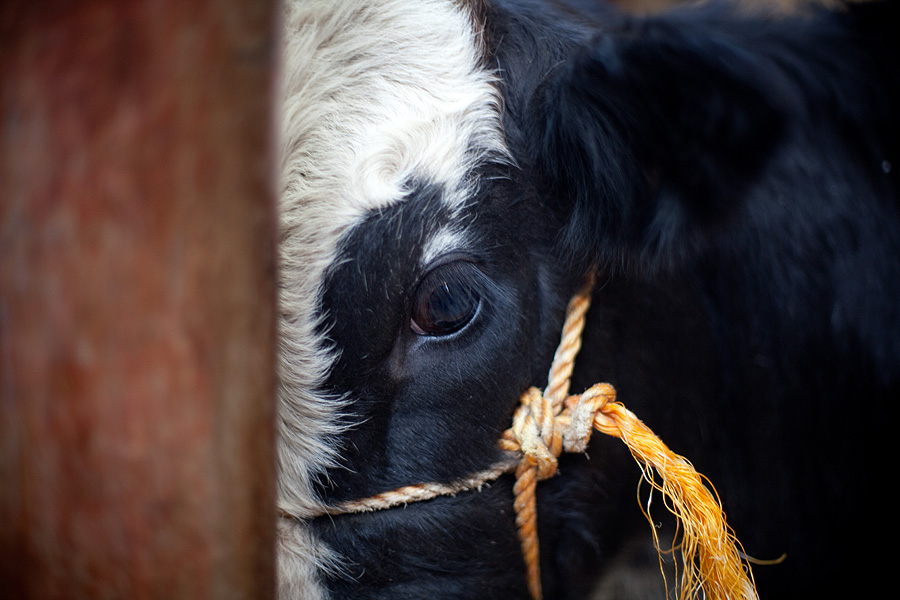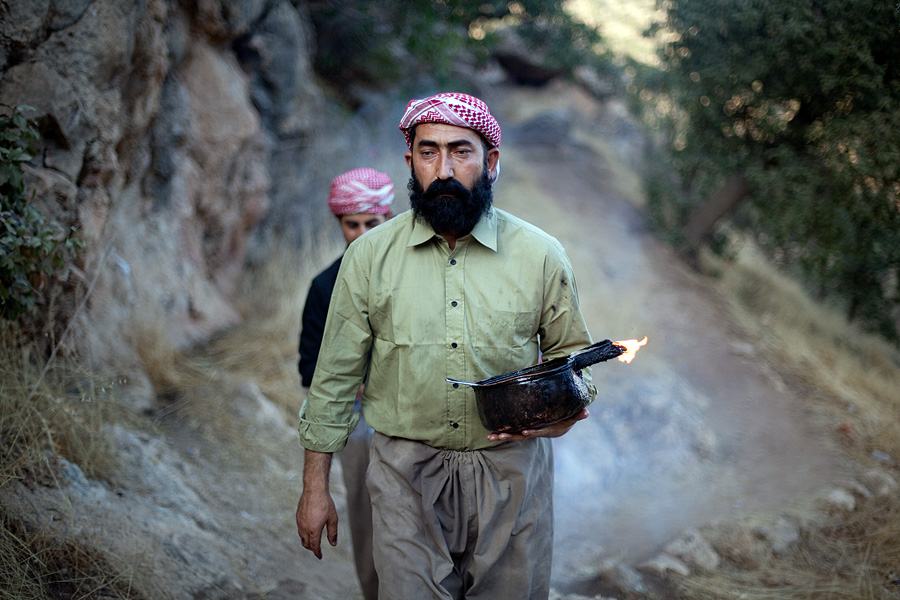Yazidi religion is of the old Iranian heritage, together with leftover Zoroastrians, with Kalash in the mountains of Pakistan, with People of Truth of Iran it links us today to the Indoeuropean ancestors who left Central Asia and spread over vast lands. The bull of Zeus, the bull of Mithra, holy cow of the Hindus are livestock of one family. Their beliefs are at the roots of what we are.
***
Religia Jazydów opiera się na starym i bogatym irańskim dziedzictwie, obok wciąż trwających przy swej tradycji zoroastrian, Kalaszy w północnym Pakistanie czy Ludzi Prawdy w kurdyjskim regionie Iranu jest jednym z żywych mostów w głęboką przeszłość, do naszych indoeuropejskich przodków, którzy opuścili stepy centralnej Azji i rozprzestrzenili się na rozległych ziemiach, od Indii po ocean Atlantycki. Byk Zeusa i Mitry to jedna rodzina z hinduską świętą krową. Te wierzenia leżą u korzeni tego kim teraz jesteśmy.
Crucial event of the most important Yazidi festival, called Jam or Cejna Cemaiya, is slaying of a holy bull. This festival is held exactly in the same time as ancient Aryan feast of Mithrakan, which celebrates creation of the world by Mithra, who killed the bull of heaven and used its body to create material world. The bull is led through temples and streets of Lalish, surrounded by pilgrims trying to catch it and tear some hair that is supossed to bring luck. It is led around the shrine of Shams al Din ( Sun of the Faith – solar symbolic is also essential in Yazidism and in cult of Mithra as well ) and then sacrificed, its flesh shared to the pilgrims.
***
Kluczowym momentem najważniejszego z festiwali Jazydów, zwanego Jam czy też Cejna Cemaiya jest zarżnięcie świętego byka. To wydarzenie ma miejsce dokładnie o tej samej porze roku co starożytny indoeuropejski festiwal zwany Mithrakan, podczas którego celebrowano stworzenie świata przez Mitrę, który zabił boskiego byka i użył jego ciała aby stworzyć materialny świat. Byk Jazydów prowadzony jest przez dziedzińce świątyń i uliczki Lalish, otoczony tłumami pielgrzymów próbujących wyrwać mu kępkę włosów, na szczęście. Zwierze trafia na końcu do świątyni Shams al Din ( co oznacza Słońce Wiary, solarna symbolika jest bardzo istotna zarówno u Jazydów jak i w mitraizmie ), gdzie po rytualnym uboju jego mięso dzieli się między pielgrzymów.
Solar symbolic is ever present in Yazidi holy places, another proof of connection to Mithraism and Zoroastrian heritage, or even older shamanic beliefs. Their calendar is related to solar cycle, religious obligation is a prayer welcoming the sunrise, the domes of temples represent rays of the sun. It is not surprising that sun is present on the Kurdish flag.
***
Słoneczna symbolika jest wszechobecna w świętych miejscach Jazydów, to kolejny przykład ich powiązań z tradycją mitraizmu i zoroastrianizmu, a nawet ze starszymi, szamańskimi wierzeniami. Ich kalendarz oparty jest na cyklu słonecznym, obowiązkowa jest tradycyjna, chociaż coraz rzadziej przestrzegana modlitwa powitania słońca o świcie, wreszcie kształt kopuł ich świątyń symbolizować ma słoneczne promienie. Nieprzypadkowo słońce jest obecne na kurdyjskiej fladze.
Another ancient tradition preserved in Yazidi religion is the worship of fire. Of course roots of it can be also found in Zoroastrianism, but looking at sacred fire being lighted in 365 sacred spots around Lalish every evening or light adoration at the night ceremony in the temple, it is hard not to think about Hindu aarti, one of the oldest common Indo-European rituals, and to marvel at continuity and unity across artificial borders.
***
Inną starą tradycją zachowaną u Jazydów jest kult ognia. Oczywiście przywodzi to od razu na myśl wierzenia zoroastrian, ale kiedy patrzy się na świety ogień zapalany przez wyznaczonego do tego fakira w 365 miejscach doliny Lalish każdego wieczora albo nocną adorację światła po ceremonii w głównej świątyni trudno nie przypomnieć sobie hinduskiego rytuału aarti, jednego z najstarszych i najbardziej uniwersalnych w indoeuropejskiej tradycji, i nie cieszyć się świadomością jedności ponad sztucznymi podziałami.














December 7th, 2013
Fire, called ‘agni’ and the Sun, ‘surya’ is also considered sacred by the Hindus and are worshiped on various occasions. The ‘agni deva’ or the fire god is believed to purify sins and negativity, while the ‘Surya deva’ is believed to be the generator of strength, vigour and sometimes life itself.
Interestingly, in Hindu mythology Surya is often depicted riding a chariot harnessed by seven horses or one horse with seven heads, which represent the seven colours of the rainbow or the seven chakras.
For more information on ‘surya’ please refer to http://en.wikipedia.org/wiki/Surya